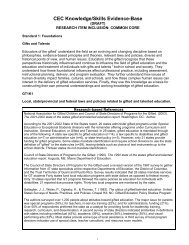Chapter One An Introduction to the Topic of Cultural Diversity - NAGC
Chapter One An Introduction to the Topic of Cultural Diversity - NAGC
Chapter One An Introduction to the Topic of Cultural Diversity - NAGC
You also want an ePaper? Increase the reach of your titles
YUMPU automatically turns print PDFs into web optimized ePapers that Google loves.
<strong>the</strong>ir cultural roots and become "Americanized." Second, <strong>the</strong> Life Adjustment movement,<br />
following World War II, categorized students in<strong>to</strong> 3 distinct groups, determining <strong>the</strong>ir<br />
educational direction, in which 20% were educated for college, 20% received vocational<br />
training, and 60% received general life skills. In <strong>the</strong> third educational movement that<br />
Graham labeled "Access," a direct response <strong>to</strong> <strong>the</strong> Brown vs. Board <strong>of</strong> Education<br />
decision, culturally, linguistically, and ethnically diverse (CLED) children were regarded<br />
as inferior by segregation that hindered <strong>the</strong>ir potential development. The fourth and<br />
current educational movement described by Graham is "Achievement,” occurring as a<br />
direct response <strong>to</strong> <strong>the</strong> Nation at Risk report (National Commission on Excellence in<br />
Education, 1983) and calling for high academic achievement for all students. State<br />
assessments and instructional reform were called for as a result <strong>of</strong> this fourth movement.<br />
Graham's chronicle <strong>of</strong> <strong>the</strong>se major educational movements in this century provides a<br />
useful background for <strong>the</strong> examination <strong>of</strong> current issues related <strong>to</strong> <strong>the</strong> underrepresentation<br />
<strong>of</strong> CLED students in gifted programs.<br />
Power <strong>of</strong> <strong>Cultural</strong> Fac<strong>to</strong>rs<br />
For <strong>the</strong> past 20 years, two perspectives <strong>of</strong> cultural differences have existed,<br />
cultural deficit and cultural differences. The former holds <strong>the</strong> belief that people reared in<br />
different environments will be different while <strong>the</strong> latter suggests different cultures exist<br />
as parallel or co-cultures (Ford, Howard, Harris, & Tyson, 2000). Teachers who employ<br />
<strong>the</strong> cultural differences perspective recognize CLED students’ individual communication<br />
and working preferences and respond in one <strong>of</strong> two ways. They ei<strong>the</strong>r recognize<br />
differences but require CLED students <strong>to</strong> adapt <strong>to</strong> fit in <strong>the</strong> common societal group, or<br />
recognize differences and modify <strong>the</strong> learning environment <strong>to</strong> support student-learning<br />
6

















